The Erie Canal crosses the state of New York from the Hudson River to Lake Erie. While it wasn’t the first waterway built in the state, it was by far the most successful government project of the 19th century. This canal was why New York is now known as the Empire State. Furthermore, it turned Rochester into one of New York’s leading cities. But how deep is the Erie Canal? This article will discuss the depth of this canal, including its purpose, width, wildlife, and more.
Where is the Erie Canal?

Because this canal transformed NYC into the economic powerhouse it is today, the U.S. Congress designated it as a National Heritage Corridor in 2000.
©Everett Collection/Shutterstock.com
Erie Canal cuts across New York State from Albany to Buffalo on Lake Erie. It was deemed an engineering marvel when it was first built in 1825. The canal directly linked NYC to the Midwest, creating an agricultural and commercial development boom. It was also the reason immigrants flocked to the sparsely populated frontiers of Indiana, Ohio, Michigan, western New York, and areas further west. Because this canal transformed NYC into the economic powerhouse it is today, the U.S. Congress designated it as a National Heritage Corridor in 2000.
What is the Erie Canal?
This canal is a 363-mile route that connects the Atlantic Ocean with the Great Lakes via the Hudson River in upstate New York.
How Was the Erie Canal Formed?

Laborers first broke ground on the canal in 1817 near Utica, New York. The laborers consisted primarily of U.S.-born men, but some Irish immigrants also participated, taking them eight years to complete.
©Joseph Sohm/Shutterstock.com
It all started with a flour merchant named Jesse Hawley in 1807. The poor merchant was struggling to get his product to the market in the Atlantic coastal cities, so he wrote several published essays while he was in debtor’s prison. Hawley wrote about a canal system from Buffalo, NY, to Albany, NY, on the Hudson River. His words caught the attention of prominent New York politicians, including the mayor, DeWitt Clinton. The mayor was convinced that the canal Hawley dreamt of would be crucial to the city’s economic advancement.
In 1817, the mayor finally saw his plan come to fruition once he became governor of New York. Laborers first broke ground on the canal in 1817 near Utica, New York. The laborers consisted primarily of U.S.-born men, but some Irish immigrants also participated, taking them eight years to complete. They cleared the land with animal power and their own hands and used gunpowder to blast through the rock because dynamite wasn’t invented until the 1960s.
How Deep is the Erie Canal?

How deep is the Erie Canal? Upon completion in 1825, the Erie Canal had a depth of four feet, with locks 90 feet long.
©Howcheng / Public Domain – License
How deep is the Erie Canal? Upon completion in 1825, the Erie Canal had a depth of four feet, with locks 90 feet long. However, to accommodate larger ships and more traffic, the canal was enlarged to seven feet deep, with locks of 110 feet.
How Wide is the Erie Canal?
The Erie Canal was originally 40 feet wide. But to accommodate more traffic and larger ships, it was enlarged to 70 feet wide.
What Animals Live in the Erie Canal?
There are various species of wildlife living in the Erie Canal, including:
Great Blue Heron

These birds live in saltwater and freshwater habitats and like to forage in agricultural fields and grasslands, where they prey on small mammals or frogs.
©Michael Munster/Shutterstock.com
These beautiful herons eat almost anything within striking distance, like reptiles, fish, amphibians, insects, small mammals, and other birds. They either use their dagger-like bills to stab larger fish or grab smaller prey with their strong mandibles. Furthermore, they often shake them to break the spines before swallowing them whole. These birds live in saltwater and freshwater habitats and like to forage in agricultural fields and grasslands, where they prey on small mammals or frogs.
Northern Leopard Frog

The Northern
leopard
frog is an ambush predator, sitting perfectly still until prey walks by, and they pounce using their powerful legs.
©Jason Patrick Ross/Shutterstock.com
Northern leopard frogs occur throughout North America, except on the Pacific Coast. They primarily inhabit areas near marshes or ponds but frequently travel to well-covered grasslands, which is why they are also known as the meadow frog. These amphibians aren’t fussy when it comes to food; they will eat anything that can fit into their mouths. The Northern leopard frog is an ambush predator, sitting perfectly still until prey walks by, and they pounce using their powerful legs. Their diet consists of flies, beetles, worms, ants, small frogs, birds, garter snakes, and sometimes, their own species.
Snapping Turtle

Snapping turtles are highly aquatic and thrive in both brackish water and freshwater ponds, marshes, lakes, streams, and rivers. These turtles often scavenge.
©iStock.com/Emily Jackson Photography
The snapping turtle is easily distinguished by its large head, stock legs with large claws, and long saw-toothed rear edge on its dark shell. This turtle is New York’s largest freshwater turtle, with a shell measuring around 16 inches. They are notorious for their aggressive behavior. However, while they attack on land, they usually flee when in the water. Snapping turtles are highly aquatic and thrive in both brackish water and freshwater ponds, marshes, lakes, streams, and rivers. These turtles often scavenge. However, they also hunt live food ranging from small invertebrates to juvenile waterfowl or small fish.
Mallard Ducks

Like most waterfowl, these ducks thrive on the water. They are adapted to feed on aquatic plants and invertebrates because of their broad, flattened bills. Additionally, their webbed feet and wide legs make them incredible swimmers.
©iStock.com/Rudolf Ernst
Mallard ducks occur throughout North America, Europe, and Asia. These birds are highly adaptable and widely distributed in various habitats and nesting sites. For example, they can inhabit almost any body of water, including lakes, rivers, ponds, wetlands, flooded fields, and canals. Furthermore, they also occur in more urbanized areas, like park ponds and beaches.
Like most waterfowl, these ducks thrive on the water. They are adapted to feed on aquatic plants and invertebrates because of their broad, flattened bills. Additionally, their webbed feet and wide legs make them incredible swimmers. They are year-round residents in the state of New York, thanks to their thick layers of down feathers and waterproof plumage, which keeps them warm through the treacherous winters. They mainly inhabit the St. Lawrence Valley, Coastal Lowland, Great Lakes Plain, and Erie Canal.
Largemouth Bass

These fish thrive in shallow, warm, sluggish streams or ponds with an abundance of vegetation. Largemouth bass are usually solitary.
©Maclane Parker/Shutterstock.com
One of the major sportsfish in New York is the largemouth bass. They might not be great fighters like the smallmouth bass, but catching them is still exciting because of their preferred habitats. These fish thrive in shallow, warm, sluggish streams or ponds with an abundance of vegetation. Largemouth bass are usually solitary. Therefore, they prefer to inhabit dense aquatic vegetation or under submerged cover, like logs, stumps, or dock pilings. It’s best to fish for largemouth bass in weedy, stumpy areas, casting with live bait or various lures, like surface plugs and plastic worms.
Carp

They currently occur in waters across the Empire State and can grow quite large. In fact, the state record is 50 pounds and 4 ounces.
©malgosia janicka/Shutterstock.com
Carp is native to Asia but was introduced into the state of New York in 1831 as food for other fish species. They currently occur in waters across the Empire State and can grow quite large. In fact, the state record is 50 pounds and 4 ounces. However, catching a carp that size is relatively rare. But, many water sources in New York are abundant in carp, ranging from 10 to 30 pounds.
The photo featured at the top of this post is © William Reagan/iStock via Getty Images
Thank you for reading! Have some feedback for us? Contact the AZ Animals editorial team.






